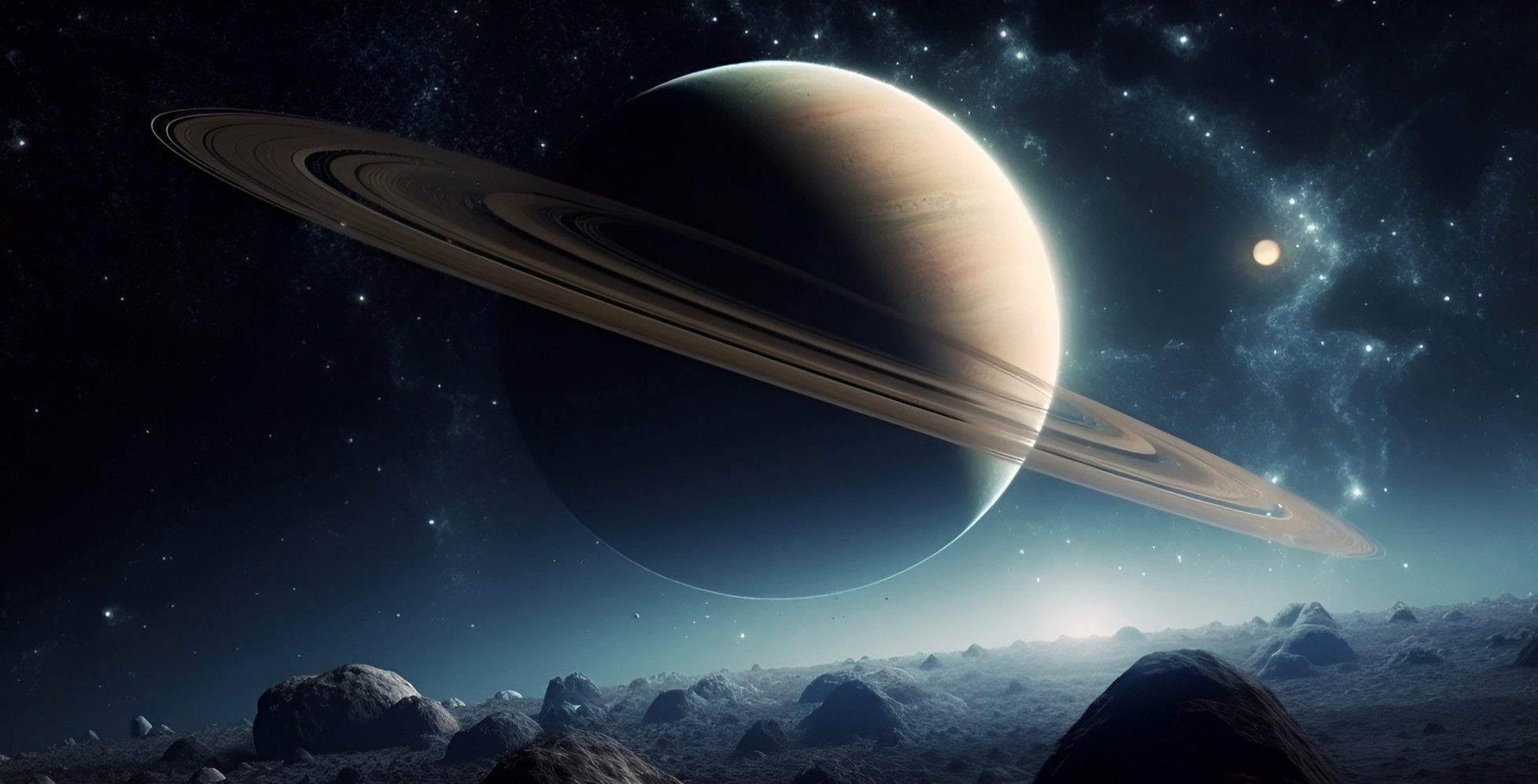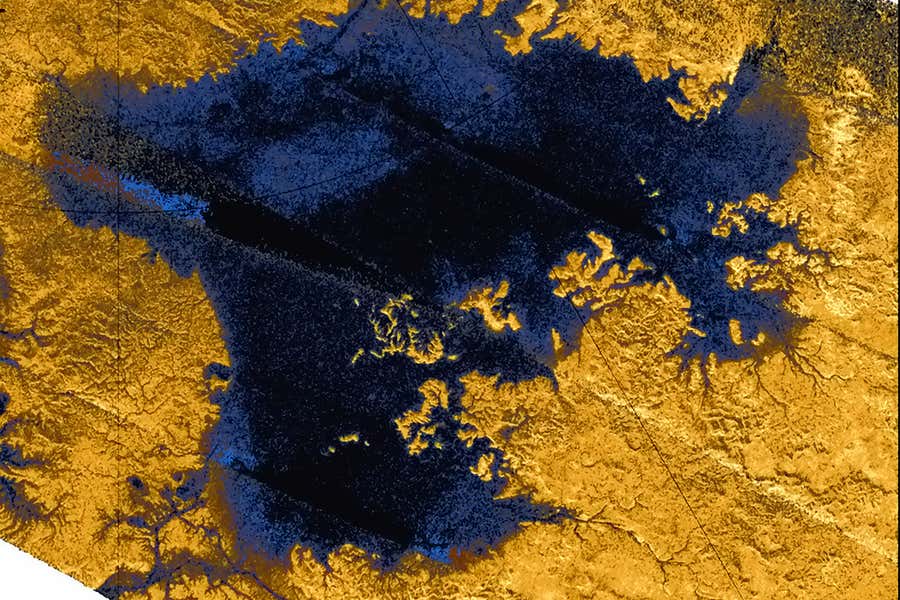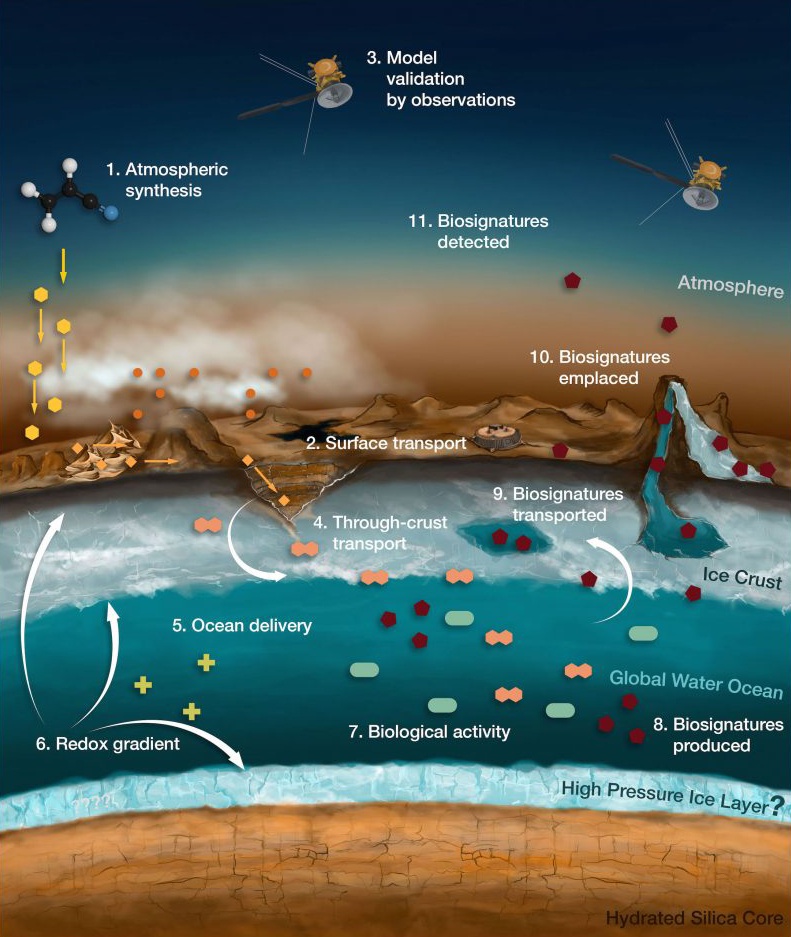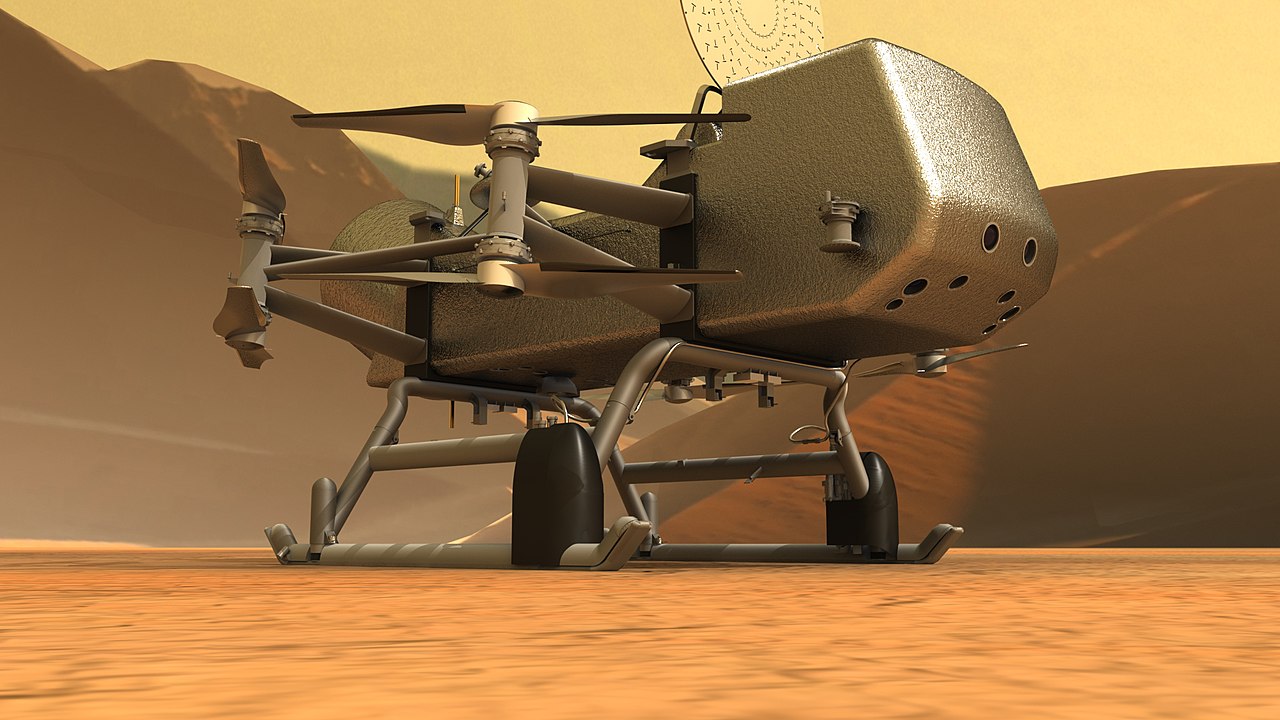Looking out into the vast expanse of space, we can’t help but wonder if there is life beyond our planet. One of the most intriguing places to explore is Titan, Saturn’s largest moon. With its thick atmosphere and a surface covered in lakes and seas of liquid methane and ethane, Titan has been a subject of fascination for scientists for many years.

With its alien landscape and unique chemistry, Titan represents a compelling target for scientists seeking to understand the workings of our solar system and the possibility of life beyond Earth. By exploring the moon and studying its chemical makeup, we may be able to shed light on some of the greatest mysteries of our universe, including the origins of life itself.
Titan, Saturn’s largest moon

Titan is one of the most intriguing and fascinating moons in our solar system. Discovered by the Dutch astronomer Christiaan Huygens in 1655, it is the largest moon of Saturn and the second-largest moon in our solar system. Titan is a unique world and has many significant features that make it stand out from other moons in our solar system.
One of the most distinctive features of Titan is its atmosphere. Titan’s atmosphere is mostly composed of nitrogen, much like Earth’s, but also contains a significant amount of methane. This makes Titan the only known object in our solar system, other than Earth, to have stable bodies of liquid on its surface. These liquid bodies form lakes and seas, but they are not made of water. Instead, they are made of liquid methane and ethane, which is a unique feature of Titan.

Another significant feature of Titan is its weather patterns. The moon experiences weather patterns similar to those on Earth, but with a unique twist due to its methane-rich atmosphere. Titan has seasons, and its weather patterns change cyclically over time. Methane clouds form, and rain falls, creating rivers and lakes on the surface. These weather patterns make Titan an exciting place to study and explore.
Comparing Titan with other celestial bodies
Titan is 5,149.46 kilometers (3,199.73 miles) in diameter, 1.06 times that of the planet Mercury, 1.48 that of the Moon, and 0.40 that of Earth. It is the only moon in our solar system with a substantial atmosphere. The atmosphere is mostly nitrogen with some methane and other trace gases. This makes Titan more similar to a planet than a moon.
In fact, Titan has many similarities to Earth. It has a weather system with clouds, rain, and even lakes and seas. However, the liquids on Titan’s surface are not water but rather liquid methane and ethane due to the extreme cold temperatures. The surface is also covered in organic molecules, which are the building blocks of life.
When comparing Titan to other moons in our solar system, we see that it is the only one with a dense atmosphere and liquid on its surface. This sets it apart from other moons like Europa and Enceladus, which have subsurface oceans but no atmosphere.
In terms of planets, Titan has many similarities to Earth, but it is much colder with an average temperature of -290°F (-179°C). This makes it more similar to Mars or even the gas giant Neptune.
Significantly, comparing Titan to other celestial bodies helps us understand what makes it unique and whether it could support life. While it may not be a perfect comparison, it gives us a better idea of the potential for life on this fascinating moon.
The possibility of life on Titan
Titan is unique because it is the only object in our solar system besides Earth to have stable bodies of liquid on its surface. While Earth’s bodies of liquid are water-based, Titan’s are methane-based, which has led scientists to wonder if life could potentially exist on the moon. While these liquids are far too cold for life as we know it, there is evidence that they could support the chemistry necessary for the development of life based on different chemical processes than what we are used to.

Additionally, recent studies have suggested that there may be subsurface oceans of liquid water on Titan, which could potentially support life similar to what we see on Earth. These oceans would be located beneath the icy crust of the moon and would be kept liquid by the heat generated by tidal forces from Saturn. While the existence of life on Titan is still purely speculative, the potential for it to exist there is a tantalizing possibility that continues to capture the imagination of scientists and the public alike.
Therefore, numerous missions have been sent to study the moon in the hopes of finding evidence of life. As we continue to explore this fascinating moon, we may eventually unlock the secrets of its potential biological activity and find out whether life truly does exist beyond our own planet.
Current research and findings
In recent years, there has been a growing interest in exploring the possibility of life on Titan, Saturn’s largest moon. The Cassini-Huygens mission, a joint venture between NASA and the European Space Agency, was launched in 1997 and arrived at Saturn in 2004, with the Huygens probe descending onto the surface of Titan in 2005. The data collected from this mission has provided valuable insights into the moon’s atmosphere, surface, and potential for life.
One of the most significant findings of the Cassini-Huygens mission is the presence of liquid methane and ethane on the surface of Titan. This suggests that the moon has a hydrologic cycle similar to Earth’s water cycle. There are also indications of a subsurface ocean of liquid water, which could potentially harbor life.
Another important discovery is the presence of complex organic molecules on Titan. These molecules are the building blocks of life as we know it, and their presence raises the possibility that life could exist on the moon.
However, the harsh conditions on Titan make it unlikely that life, as we know it, could survive. The moon’s surface temperature is around -290 degrees Fahrenheit, and the atmosphere is composed primarily of nitrogen and methane, which are toxic to humans. Nonetheless, the discovery of organic molecules and the potential for a subsurface ocean make Titan an intriguing target for future exploration and research.
The potential for future exploration
The potential for future exploration of Titan is vast, and it is an exciting prospect for scientists and space enthusiasts alike. The Cassini mission provided us with invaluable information and insights into this unique moon, and there are plans in motion for future missions to Titan, such as the Dragonfly mission scheduled for launch in June 2027 (planned).

Dragonfly is a NASA mission that aims to send a rotorcraft lander to Titan’s surface to explore and study its environment. This mission will allow scientists to investigate the moon more closely than ever before and potentially uncover more evidence of life or conditions conducive to life.
There are also proposals for a Titan Saturn System Mission, which would include sending probes to explore Titan’s lakes and seas, as well as studying the interactions between Titan and Saturn. With advances in technology and propulsion systems, the potential for further exploration and discovery on Titan is immense.
The possibility of finding life on Titan is still uncertain, but the potential for discovering more about the moon’s unique atmosphere, geography, and potential for hosting life is vast. Future missions to Titan hold the promise of exciting discoveries and a deeper understanding of our solar system and the potential for life beyond Earth.
The challenges of exploring Titan
Exploring Titan, Saturn’s largest moon, is an exciting prospect for scientists and space enthusiasts alike. However, it comes with its own set of challenges. Titan is covered in a thick, hazy atmosphere that obscures the surface from view. This means that traditional methods of exploration, such as using cameras or telescopes, are not possible.
To overcome this challenge, NASA’s Cassini spacecraft used radar to map the surface of Titan during its mission. The radar was able to penetrate through the thick atmosphere, providing scientists with a detailed view of the moon’s surface features.
Another challenge of exploring Titan is it’s extremely low temperature, making it one of the coldest places in our solar system. This extreme cold makes it difficult to design equipment that can withstand the harsh conditions and still function effectively.
Additionally, the distance between Earth and Titan presents logistical challenges for missions. It takes around 7 years for a spacecraft to reach Titan, and communication delays mean that real-time control is not possible. This requires teams to carefully plan and prepare for each stage of the mission, as any errors cannot be corrected immediately.
Despite these challenges, the potential for discovering life on Titan is a compelling reason for continued exploration. The moon’s atmosphere contains organic compounds, and there is evidence of liquid hydrocarbons on its surface. These factors make Titan an intriguing target for astrobiology research and could potentially lead to new discoveries about the origins of life in our solar system.
The ethical considerations of exploring extraterrestrial life
As we explore the possibility of finding extraterrestrial life on Titan, there are certain ethical considerations that need to be taken into account. If we do discover life on Titan, what are the implications? How will it affect our perception of life and the universe?
One of the biggest ethical concerns is the risk of contamination. If we do find life on Titan, we must ensure that we don’t contaminate it with Earth’s microorganisms when we collect samples. We need to make sure that we take all necessary precautions to prevent any harmful contamination that could jeopardize the possibility of finding life on Titan.
Another ethical consideration is the impact that our exploration may have on the potential life forms on Titan. If we do find life, we need to make sure that we do not harm it in any way. We need to ensure that our exploration and investigation do not have a negative impact on the environment and the potential life forms that we may find.
In other words, we need to approach the exploration of extraterrestrial life with great care and consideration for the potential impact and implications. We must prioritize the safety of any potential life forms and take all necessary precautions to prevent any harm or contamination.
Conclusion: Final thoughts on the possibility of life on Titan
After examining the various factors that could support the existence of life on Titan, it’s clear that the possibility cannot be ruled out entirely. The presence of water, organic molecules, and a subsurface ocean indicate that there could be conditions on Titan that could support life similar to what we know on Earth. However, the extremely cold temperatures, lack of sunlight, and high levels of radiation make it a challenging environment for life to thrive (though it’s not impossible).
Furthermore, our exploration of Titan is still in its early stages, and there is much we have yet to discover about this mysterious moon. Future missions and research could uncover new evidence that either supports or disproves the possibility of life on Titan.
In conclusion, while we cannot say for certain if there is life on Titan, the evidence and scientific research thus far suggest that it is a possibility worth exploring further. The discovery of life beyond Earth would be one of the most significant scientific breakthroughs in human history and could provide invaluable insights into the origins of life and the potential for life to exist beyond our planet.
Lastly, don’t forget that oceans cover around 70 percent of the Earth’s surface so it shouldn’t be surprising that when it comes to exploration, we’ve only just scratched the surface. So far, human eyes have only seen around 5 percent of the ocean floor – means 95 percent is still unexplored. So, who knows what’s brewing up in the depth of Titan’s ocean?




